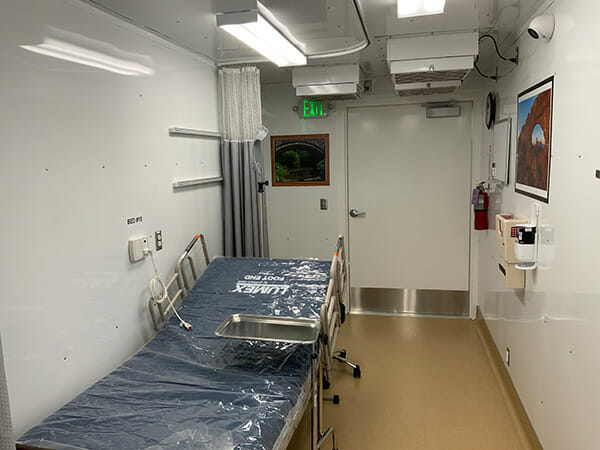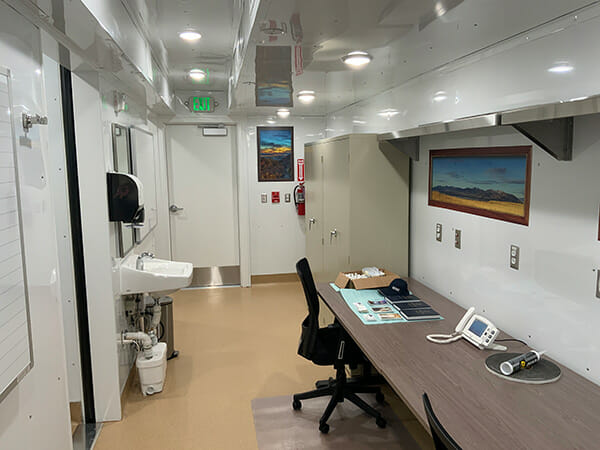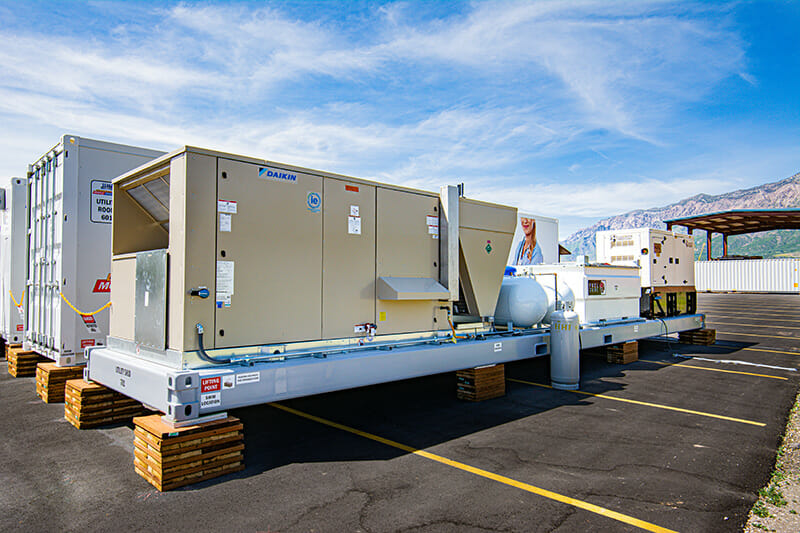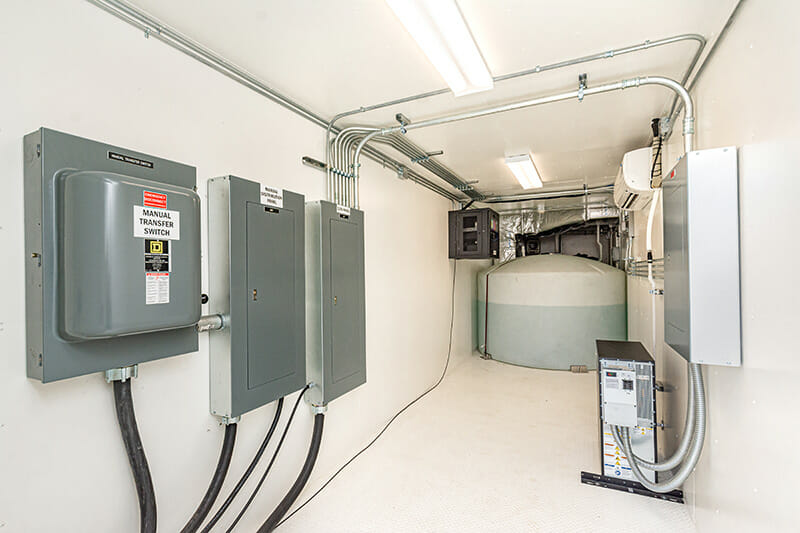HHI Corporation Develops & Donates State-of-the-Art Mobile Triage Unit

Cliff Hokanson’s parents founded HHI Corporation in 1971. Hokanson studied civil engineering at Utah State University, and during that time, he worked for a couple of years at a nonprofit research corporation that developed defense and space technologies. He joined the family business full-time in 1996. Hokanson is now the Executive Vice President of HHI Corporation, based in Utah, USA.
Before COVID-19, there was Ebola
HHI has extensive experience with precision engineering in the defense and aerospace industries, including manufacturing aircraft maintenance stands for 15 years. They’ve been doing industrial construction for 48 years for the U.S. Department of Defense and other clients. And they have 30 years of experience with biological and chemical containment.
In 2014-2016, there was an outbreak of the deadly infectious disease, Ebola, in west Africa. When American medical professionals treating Ebola patients were infected and became sick, they were flown back to the United States for treatment. However, to keep the flight crew and other passengers safe from the virus, it was necessary for the sick patients to travel inside biocontainment units called Containerized Bio-Containment Systems (CBCS).
The CBCS units had to be manufactured so that even if there was loss of pressure inside the plane, the virus wouldn’t seep out of the box and into the rest of the airplane. Working with MRIGlobal, a nonprofit research lab, HHI was tasked with designing and manufacturing these units.
“This is something that had never been done before and we had to do it in six months!” says Hokanson. “We designed it, fabricated and built it, and got it third-party tested, all in about 190 days.”
HHI built a total of four of these biocontainment pods for the U.S. Department of State. The units involve complex, precision engineering and were manufactured to a significantly higher standard than Biosafety Level 4 (BSL-4), the CDC’s highest standard for biocontainment. “The entire door system is a new invention. We had to make sure that patients would be safe, even if the units were sitting on the tarmac for 12 hours. So they each have their own power source, HVAC system, and adequate air flow,” Hokanson explains. “Medical-grade oxygen needed to be available. And the staff inside the unit needed to be able to communicate with the outside.”

The layout of HHI Corporations' Mobile Triage Unit (MTU)—seen here outside the Jackson Memorial Hospital in Florida—includes four patient rooms with three beds each, nurses stations and support equipment. Systems include UPS power circuits, insulated wall and ceiling panels, hospital grade flooring with welded joints, two 1,500 gallon tanks for fresh and waste water, HVAC system with 18 air exchanges per hour, visual air flow sensors, single pass air system, HEPA filters, seven days of power via diesel generator, and fire alarm system with dialer. It also includes a HIPAA-approved networking package to integrate with existing hospital/medical facilities communications.
The COVID-19 Cruise Ship
Then, this year, Hokanson happened to see those same CBCS pods on TV — this time on flights bringing home COVID-infected patients from the Diamond Princess cruise ship, which had been quarantined off the Japanese coast.
He felt both proud and inspired.
HHI had the experience and skills to do something significant to help during the COVID-19 pandemic. So the team put their heads together and designed the Mobile Triage Unit. Once they developed the prototype, they got feedback and tweaked the design.
A press release from HHI describes the details of the MTU:
The layout of the MTU includes four patient rooms with three beds each, nurses stations and support equipment. Systems include UPS power circuits, insulated wall and ceiling panels, hospital grade flooring with welded joints, two 1,500 gallon tanks for fresh and waste water, HVAC system with 18 air exchanges per hour, visual air flow sensors, single pass air system, HEPA filters, seven days of power via diesel generator, and fire alarm system with dialer. It also includes a HIPAA approved networking package to integrate with existing hospital/medical facilities communications.
“I’m pretty sure the MTU is the first of its kind. It’s mobile, can be completely set-up within a couple of days, and can withstand hurricane-force winds.”
Related Listening:
Modular Triage Units for COVID-19 w/ HHI Corporation
In this episode, MBI marketing director John McMullen talks with Cliff Hokanson, Executive VP of HHI Corporation, about HHI's new Mobile Triage Units. Cliff walks listeners through the layout of the units, describes their functions, and talks about the requirements for building modular healthcare facilities.





Supply Chain Challenges
Like other manufacturers, though, HHI struggled with disrupted supply chains. “Ordinarily, we have lots of suppliers for HEPA filters. These are a crucial component of the MTU because they capture the viruses as the air moves through them,” explains Hokanson. “But it was hard for suppliers to get enough of them, because factories were getting shut down and not making them.”
In fact, one of HHI’s usual suppliers was unavailable because she was sick with COVID-19 herself. Eventually, one supplier who knew what HHI was trying to do decided to put a hold on a delivery to another customer whose project wasn’t as urgent, and to prioritize HHI’s more urgent need.
“We had similar things happen for the generators, aluminum sheet stock, and flooring material,” says Hokanson. “Companies said they would work overtime shifts to get us what we needed. People really wanted to be part of this project.”
Inspiration
Instead of selling the first MTU, Hokanson decided to donate it to a healthcare facility that could make good use of it.
“I’m sure later in the year my accountant will say, ‘What were you thinking? Don’t you know how to add!’” laughs Hokanson. “But I believe in inspiration and I was inspired to donate it.”
Hokanson sent out an email to all his contacts and asked them to email all their contacts to find a suitable recipient for the MTU. In the end, HHI selected the Global Surgical Medical Support Group. The Jackson Memorial Hospital in Florida is housing the unit — and the medical staff are thrilled with the state-of-the-art addition to their facility.
HHI has a couple more MTUs that are close to completion. They’ll be ready to deliver in less than 6 weeks. Hokanson notes that we were unprepared for this pandemic, even though experts had been warning us for years. The MTU is a way that healthcare systems can be better prepared for outbreaks of future infectious diseases — as well as helping them cope this time around.
The MTU can also be used for other health crises — hurricanes and earthquakes to car accidents and mass shootings. They’re built to withstand hurricane force winds up to 185mph (298km/hr), and are designed to comfortable in outside temperatures between -20F to 110F (-29C to 43C). If necessary, they can be self-sufficient at full capacity for up to 7 days.
“We built it. But it’s inspiration and a lot of collective brainpower that made it happen.”
About the Author: Zena Ryder is a freelance writer, specializing in writing about construction and for construction companies. You can find her at Zena, Freelance Writer or on LinkedIn.
More from Modular Advantage
Resia: Breaking All the Rules
Resia Manufacturing, a division of U.S.-based Resia, is now offering prefabricated bathroom and kitchen components to industry partners. Its hybrid fabrication facility produces more precise bathroom and kitchen components (modules) faster and at lower cost than traditional construction. Here’s how Resia Manufacturing does it.
How LINQ Modular Innovates to Bring Modular To The Market in the UAE and Beyond
LINQ Modular, with an office and three manufacturing facilities in Dubai, is a modular firm based in United Arab Emirates. The company is on a mission: to break open the housing and construction markets in the Gulf Cooperation Council (GCC) area with modular.
ModMax: Redefining Modular Construction with Confidence and Precision
ModMax was born out of frustration—frustration with five persistent pain points in modular construction: Permitting bottlenecks. Production delays. Rigid designs. Disconnect between “the office” and the field. Lack of transparency and communication.
LifeArk: Disaster-Resilient Housing from Recycled Plastic and 100-year-old Technology
Wee compares LifeArk’s housing units to Yeti coolers, as they are built similarly. Each component takes 15 to 20 minutes to manufacture, has an R-value of 40, and includes molded slots and chases for wiring, plumbing, fire sprinklers, and other utilities.
Building the Future of Modular Edge Infrastructure
The edge data center market is expanding rapidly, driven by the surge in AI workloads, IoT adoption, and the need for localized compute power. In these environments, sustainability, scalability, and reliability are non-negotiable. Cooling is among the most complex challenges for operators—and one of the most decisive factors in long-term success.
Accelerating Light-Gauge Steel Construction: A Semi-Automated Digital Workflow for Off-Site Projects
For construction professionals, the message is clear. By adopting semi-automation and digitalization, companies can deliver projects faster, more accurately, and more profitably, while also building stronger collaboration across teams. The approach is not about replacing people with machines, but about empowering people with better tools and processes.
Why Modular Data Centers Are Gaining Momentum
Artificial intelligence, high-performance computing, and edge applications push the limits of traditional “stick-built” data centers. They take years build, often struggle with high density workloads, and aren’t optimized for deployments near end users. Modular data center platforms are purpose-built to address these challenges, offering flexibility and scalability to adapt to evolving technologies, while opening new opportunities for the modular construction industry.
Supply Chain Innovation in Action: 5 Habits Every Modular Leader Should Practice
By applying these principles to supply chain practices — collaborative planning, strategic procurement, scenario modeling, digital tools, and transparent forecasting — construction leaders can build value chains that are not just efficient and agile, but truly innovative.
Exploring the Role of Modular Integrated Construction (MiC) in Advancing Circular City Principles – A Survey of Stakeholder Perspectives
The survey findings highlight the significant potential of Modular integrated Construction (MiC) in advancing the development of circular cities. By reducing costs, accelerating construction timelines, and minimizing waste generation, MiC offers a promising approach to sustainable urban development.
The Use of MS POLYMER™-Based Sealants and Adhesives in Modular Building
These products combine flexibility and elastic recovery with excellent adhesion to different substrates and have already shown their usefulness in traditional construction. Now it’s time for them to be put to use in the modular construction industry.










